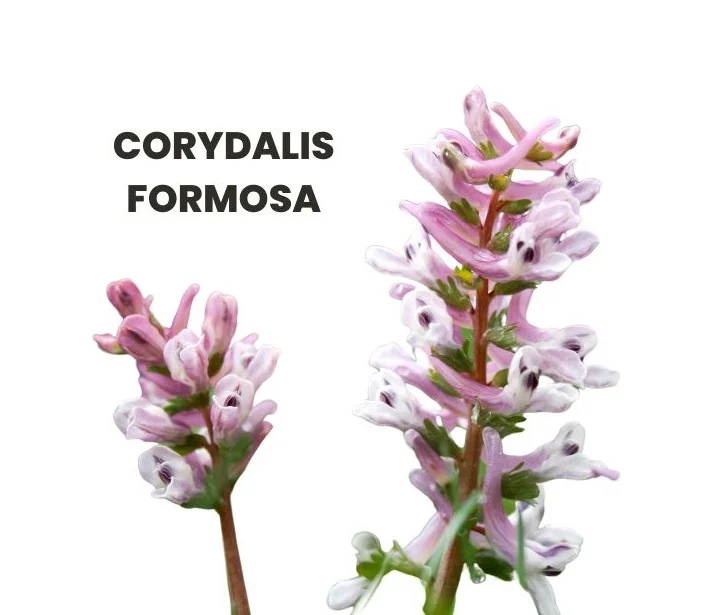Corydalis formosa, commonly known as Turkey-pea, is a perennial herbaceous plant belonging to the Papaveraceae family.
This plant is characterized by its delicate, fern-like leaves and tubular flowers, which range in color from pale yellow to lavender.
Traditionally, Corydalis formosa has been used in herbal medicine for various ailments, particularly those related to syphilis, ulcers, and chronic diseases.

Table of Contents
ToggleSOURCE INFORMATION
Scientific Classification
- Kingdom: Plantae
- Clade: Angiosperms
- Clade: Eudicots
- Clade: Rosids
- Order: Papaverales
- Family: Papaveraceae
- Genus: Corydalis
- Species: Corydalis formosa
Origin and Historical Facts
- Corydalis formosa is native to North America, particularly in the eastern and central United States and parts of Canada.
- Indigenous peoples historically utilized this plant for its medicinal properties, particularly for treating pain and various chronic conditions.
- In modern herbal medicine, it has gained recognition for its efficacy in managing symptoms related to syphilitic affections and chronic diseases.
DRUG PATHOGENESIS
Corydalis formosa is noted for its ability to affect the mucous membranes and the skin, specifically addressing conditions associated with atony and debility.
Its action is particularly pronounced in cases of:
- Syphilitic Ulcers: It can help manage ulceration in the mouth and throat, especially in chronic cases.
- Cancer Cachexia: This plant may provide symptomatic relief in patients experiencing severe weight loss and tissue deterioration associated with cancer.
PHYSICAL CONSTITUTION
The physical constitution of individuals requiring Corydalis formosa tends to present as:
- Flabby and Doughy Tissues: Patients often exhibit soft and under-toned tissues.
- Cold Sensation: The affected areas may feel cold to the touch, indicating poor circulation or vitality.
- Broad, Clean Tongue: A characteristic appearance of the tongue in these individuals, indicative of systemic issues rather than localized inflammation.
DIATHESIS
- Atony: Predominantly seen in patients with chronic illnesses where there is a lack of vitality and muscle tone.
TEMPERAMENTS
- Patients may exhibit melancholic or phlegmatic temperaments, marked by a tendency toward sadness, fatigue, and a general lack of energy.
KEY CHARACTERISTICS
- Ulcers: Associated with syphilis and chronic inflammatory conditions.
- Gummata: These are soft, tumor-like growths that can occur in syphilis and other chronic diseases.
- Night Pains: Pain that worsens at night, common in chronic diseases and cancer cachexia.
DETAILED ORGAN SYMPTOMS
MOUTH AND FAUCES
- Ulcers: Corydalis formosa can help treat ulcers in the mouth and throat, often associated with syphilitic infections.
- Clean, Broad Tongue: Indicates a lack of inflammation but significant systemic issues.
SKIN
- Dry, Scaly Scabs: Common in older patients, indicative of chronic skin conditions.
- Swollen Lymphatic Glands: Often associated with underlying infections or systemic diseases.
GASTRIC SYMPTOMS
- Gastric Catarrh: Indicated in patients with inflammation of the stomach lining, often presenting with digestive discomfort.
MODALITIES
- Worse: Symptoms often exacerbate at night, particularly in the presence of cold, damp conditions.
- Better: Symptoms may improve with warmth and rest.
WHAT ARE MODALITIES IN HOMOEOPATHY?
RELATIONSHIP WITH OTHER DRUGS
- Nitric Acid (Nit ac): Often used in cases of ulcers and syphilitic conditions.
- Potassium Iodide (Kali iod): Known for its use in syphilitic infections and skin conditions.
- Hydrofluoric Acid (Fluor ac): Employed in various chronic ailments, particularly those with glandular involvement.
DOSAGE
- Preparation: Tincture
- Recommended Dose: Twenty drops three times a day, adjusted based on individual response and severity of symptoms.
Frequently Asked Questions (FAQs)
What conditions does Corydalis formosa treat?
- It is primarily used for syphilitic affections, chronic diseases with atony, and ulcers in the mouth and throat.
How does it work?
- It is believed to help stimulate vitality in flabby tissues and improve symptoms related to chronic infections.
Can it be used alongside other medications?
- While it can be used in conjunction with other treatments, it’s crucial to consult with a healthcare provider to avoid interactions.
Glossary of Difficult Words
- Atony: Lack of normal muscle tone or strength.
- Cachexia: A state of general ill health and malnutrition, often associated with chronic disease.
- Gummata: Soft tumor-like growths that occur in certain diseases, including syphilis.
- Catarrh: Inflammation of a mucous membrane, leading to excessive discharge.
- Phlegmatic: A temperament characterized by calmness, reliability, and a tendency to be slow to act.
Conclusion
Corydalis formosa presents a valuable option in the homeopathic treatment of chronicdiseases, particularly those associated with syphilitic infections and cachexia.
Its ability to address tissue vitality and manage ulcerations makes it a significant remedy in herbal medicine.
